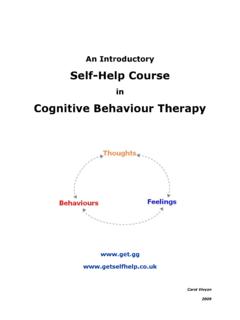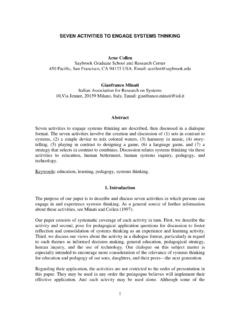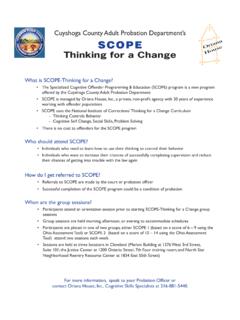Transcription of Facilitator guide - Thinking about Organizational Change
1 Better Business Learning Change Activation Toolkit v1. Branded Well LTD. Unauthorized use or duplication strictly prohibited. Page 1 of 10 Learning objectives Understanding the types of changes that organizations undergo. Recognizing the main features of organizations upon which Change initiatives focus. Recognizing that Change initiatives may operate upon various levels within organizations. Awareness of the role of dedicated Change leaders in leading Change initiatives. How to use this module Before beginning a Change initiative, use this material to demystify the nature of Change and assure stakeholders that Change is a process that organizations must undergo in order to align themselves with a shifting environment.
2 When bringing together a Change management leadership team. In order to clarify the distinction between Change management initiatives and continuous improvement efforts. To illustrate the variety of broad forces and influences that organizations face. When briefing on the nature of a Change program to those responsible for a quality or continuous improvement process. This module outlines the distinction between incremental and transformational Change , explains the major features of organizations upon which Change operates and describes how the support of members at all levels of organizations maximizes the likelihood of success.
3 Facilitator guide Thinking about Organizational Change Facilitator guide : Thinking about Organizational Change Better Business Learning Change Activation Toolkit v1. Branded Well LTD. Unauthorized use or duplication strictly prohibited. Page 2 of 10 Activity Target Audience Suggested timing (dependent on group size and experience level) Activity 1 Video: Thinking about Organizational Change All learners 15 - 30 minutes (video duration 5:00 mins) Activity 2 Attitudes to Change All learners 10 - 15 minutes Activity 3 Appreciative Enquiry All learners 40 - 50 minutes Activity 4 Self Assessment: Changing Me All learners 30 minutes Wrap-up & commitments All learners 15 minutes Terminology Change initiative An organized, concerted effort to alter part or all of an organization.
4 Incremental Change Continuous improvements made to the organization in an ongoing, adaptive manner. These are gradual changes to the current state. Incremental Change does not usually challenge the existing culture of an organization. Transformational Change Change which is not merely an extension of, improvement or modification of the current state of an organization, but one which involves a complete and fundamental Change to the organization, involving changes to processes and systems, people, structure and/or culture. Stakeholder A person or group which has an interest in the process or result of a Change initiative.
5 They do not necessarily have to be directly or indirectly affected by a Change initiative to be a stakeholder; some stakeholders are unaffected but can wield direct or indirect influence, such as damaging an organization s reputation or encouraging public support. Examples of stakeholder groups include: customers, groups of employees, people with specific roles within the organization, the media, government, society, competitors, trades unions, campaign groups, etc. Facilitator guide : Thinking about Organizational Change Better Business Learning Change Activation Toolkit v1.
6 Branded Well LTD. Unauthorized use or duplication strictly prohibited. Page 3 of 10 Description The module subject-matter is introduced using a short animated video. The knowledge check and personal reflections questions are then used to explore learners understanding and experience before moving on to other connected activities. Facilitators can make use of a range of techniques such as brainstorming or debates to explore the knowledge check questions. Use examples of learners experiences in the activities which follow. Resources/materials Required: The introductory video. Flipchart and marker pens.
7 Dependent on the technique chosen, optional resources could include: Terminology flash-card printouts Instructions Introduce the video which explains the concept of Organizational Change . (Slide 2) Following the video, use the questions in the knowledge check to guide the conversation, exploring the learners views on this subject. (Slides 3 to 6) Knowledge check (Slides 3 to 6) What forces affect organizations, prompting them to adapt to shifting circumstances? Examples include: market conditions such as new markets opening up, new competitors, changing prices or regulation; changes in technology, whether in IT, manufacturing, communication, product delivery, etc.
8 ; the expectations of stakeholders - be those customers, employees, government, regulators, society, etc.; customer demands, such as requests for specialized products, integration with other organizations products, availability, etc.; input costs, which may require either finding new sources of inputs or ACTIVITY 1 Video: Thinking about Organizational Change Facilitator guide : Thinking about Organizational Change Better Business Learning Change Activation Toolkit v1. Branded Well LTD. Unauthorized use or duplication strictly prohibited. Page 4 of 10 finding alternative ways to produce a product; competition from alternative suppliers of your product.
9 These forces may mean an organization has to stop doing something, start doing something new or do something differently. What are two major types of Change and the differences between them? Incremental Change involves continuous improvements made to the organization in an ongoing, adaptive manner. These are gradual changes to the current state. Incremental Change does not usually challenge the existing culture of an organization. Transformational Change involves Change which is not merely an extension of, improvement or modification of the current state of an organization, but one which involves a complete and fundamental Change to the organization, involving changes to processes and systems, people, structure and/or culture.
10 Name four features of organizations that Change initiatives typically operate on and outline typical components within those features that are acted upon. Processes and systems changes to technologies, information flows, how resources are allocated and the design of production systems People influencing the way in which people within an organization communicate, motivate each other, approach problems, work in teams and develop new skills. Structure Changes to an organization s hierarchy of authority, job roles and structural characteristics such as the organization of its business units or internal groups.









